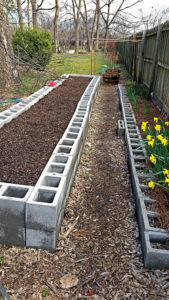“Lasagna” Gardening
Posted on October 31, 2016 by bob in Yard 'N Garden
My father, Papa John, as he was fondly called by his family, took great pride in his vegetable garden during the later years of his life. My grandmother  was an avid gardener too, working mostly with flowers. I’m not sure which of the family lines my gardening-genes came from, but I began to really enjoy my yard and flower garden ten years or so ago.
was an avid gardener too, working mostly with flowers. I’m not sure which of the family lines my gardening-genes came from, but I began to really enjoy my yard and flower garden ten years or so ago.
If anything is blooming, it finds its way into my house to a vase for my husband and me to enjoy, or for friends and family who might come over for a visit. The truth is, I love color and fresh flowers in my home all year ‘round. On occasion, I’ve been known to buy a bouquet at the grocery store if I can’t come up with anything out of my garden.
Four years ago we moved to a small patio home with a very small garden. My husband joked that I brought as many plants to Alabama as we had pieces of furniture from our home in South Carolina.First we added truckloads of good soil to the garden and planted it with things I had rooted or dug up from our previous home, as well as adding some new plants.
Since we moved to Montgomery and established our beds in the front of the house and in the patio garden on the side of the house, I began to look into “lasagna gardening.” It interested me for several reasons. For starters, we didn’t have to till up the ground. We just chose an area for the garden, laid cinder blocks and began building layers — like you do when making lasagna. I’m sure that’s how it got its name!
We chose an area across the alley behind our house in a spot that receives plenty of sunlight. The first layer we put down was cardboard (you can also use layers of newspaper) to keep the weeds out. Then we alternated layers of “brown” (carbon) with layers of “green” (nitrogen). The “brown” could be black and white shredded newspaper, shredded brown paper bags, peat moss, pine needles or pine bark, or leaves. The “green” can be lawn clippings, vegetable and fruit scrapes, cuttings, coffee grounds and crushed egg shells. We topped our creation off by adding three to four inches of peat moss, moo-nure (manure), and garden soil. We also watered heavily between each layer.
I planted zinnias, daffodils, hyacinths, lilies, tulips and gladiolas in my cut-flower bed. I also planted marigolds in the holes of the cinder blocks. The flower garden did so well last year that we’ve made another raised bed this year, where I will try my hand at growing vegetables. We’re using the same lasagna layering technique to build up the soil as we did with the cut-flower bed. The new bed is situated east to west and the taller veggies will be planted on the north side so they don’t cast a shadow on the shorter veggies.
With any luck, I’ll discover I possess gardening genes from both my flower-growing grandmother as well as my vegetable-growing dad.
Claire Hubbard, an intern in the 2016 Master Gardener Class, lives in Montgomery. For more information on becoming a master gardener, visit www.capcitymga.org or email capcitymga@gmail.com.
Capital City Master Gardener Association
FREE Lunch & Learn , 12:00-1:00 pm
2 Nov. — Care and Selection of Garden Tools (Mary McCroan)
7 Dec. — Natural Holiday Decor (Anna Owen, Ginger Gammon)
Armory Learning Arts Center, 1018 Madison Ave. Bring sack lunch. Drinks provided. For more information call (334) 270-4133.









